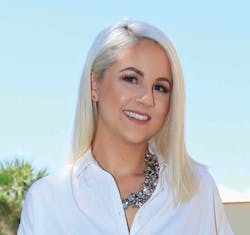Aspects of mobile dentistry for the dental hygienist: Is it possible to provide mobile services in my state? Part 1 of 4
The mobile dentistry movement continues to gain traction as one of the most popular up-and-coming trends within the profession. It’s never been easier for dental hygienists to deliver mobile services to patients—whether one day a month or as a full-time career.
As dental practices and health-care organizations increasingly explore ways to include mobile delivery into their current model of care, the mobile dentistry movement continues to gain traction as one of the most popular up-and-coming trends within the profession. For clinicians around the country, adding mobile services to their current scope of offerings is a great way to connect with the local community, expand patient reach, increase profit, and find fulfillment and advancement within the career. And while many dental hygienists who have considered a career in the mobile context are sometimes unsure where or how to begin, the good news is it’s never been easier for dental hygienists to deliver mobile services to patients—whether one day a month or as a full-time career.
Throughout this year, RDH magazine and I have partnered together to provide an overview of what it means for dental hygienists to take oral health care to places where our patients eat, sleep, live, learn, play, and pray. We will explore the various models of care dental hygienists can utilize to provide these services, whether the services need to be completed in collaboration with a supervising dentist, and the best tools, practices, and policies to implement. We will discuss how to create the necessary support systems for long-term success and also bust some common myths along the way.
Myth: ‘It’s not possible for me to provide mobile dental hygiene services in my state.’
Every single week, dental hygienists from across the country reach out to me to share their stories and passions, most of which emphasize a desire to reach more patients and do more for those under their care. Frequently these hygienists will comment on how they don’t think it’s possible for them to provide mobile dentistry in their state. The good news over the last decade is that the industry has made huge strides in this area—thanks to innovative technology and expanding dental regulations—and these improvements are now making it possible for dental hygienists to provide mobile services in most states. For the first installment of this series, let us begin by defining mobile dentistry, discussing how it may be possible for you to engage, and then considering what to do if you live in a highly regulated or restrictive state.
Mobile dentistry versus direct access
The first thing to note is that many dental hygienists believe the primary way to provide mobile dentistry is through direct access of dental hygiene services. Many use the terms “mobile dentistry” and “direct access” interchangeably. While mobile delivery and providing direct dental hygiene services are closely related and often complement each other, it is important to remember that they are not identical and are, in fact, regulated separately. For example, it is entirely possible for a dental hygienist to provide mobile dentistry within a state that does not allow direct access to dental hygiene services. How, precisely? The dental hygienist would simply provide care under the supervision of a dentist within a mobile organization.
Various models of supervision
When exploring how it is possible for a dental hygienist to provide mobile services, the first place to begin is by studying a particular state’s dental practice act. Pay special attention to written references related to supervision requirements, telehealth/telemedicine, and mobile regulations. It is important to determine whether or not a dental hygienist must collaborate with a supervising dentist and, if so, what type of collaboration is necessary. In some areas of the United States, dental hygienists can only provide preventive services without the on-site supervision of a collaborating dentist, while in other areas of the country hygienists may provide the full scope of services. Typically, mobile dental hygiene services can be provided under the following three types of supervision models:
No supervision—In a handful of states such as California, Maine, and Oregon, dental hygienists can own a dental practice, work independently of a dentist, and therefore require no supervision from a dentist.2-4
In collaboration with an off-site dentist—While the majority of dental hygienists fall under this category, the types of collaboration differ from state to state and definitions vary. Some states require a written agreement, some require a dentist to examine the patient prior to the provision of dental hygiene services, and still others allow for communication with a dentist through electronic technologies. Minnesota, Arizona, and Arkansas are examples of states that utilize this type of collaboration.5-7
In collaboration with an on-site dentist—States that are most restrictive regarding the supervision of dental hygienists require the on-site supervision of a dentist, many times referring to this as direct or indirect supervision. Alabama is an example of a state in which a dentist is required to provide on-site supervision whenever a dental hygienist is treating patients.8
Mobile dentistry regulations
After considering what types of supervision are necessary for a dental hygienist to provide mobile services, the next step is to review all rules and regulations regarding mobile dentistry. Note that these regulations can come from dental and dental hygiene regulatory agencies, as well as from medical agencies such as the department of health or the board of medicine.
Interestingly, and depending on the state in which you practice, mobile regulations may be just a few words in length or can encompass many pages. Particular regulations might require a mobile organization to register with the state, pay a fee, or maintain patient records at each clinic site. For example, mobile organizations in Oregon are simply required to follow the same regulations as a traditional, fixed dental practice, whereas mobile dentistry organizations in Arkansas must obtain a mobile clinic permit, pay a fee, maintain general liability insurance, have a written procedure for follow-up care, provide handicap access via a ramp or lift, and more.4,7
Teledentistry regulations
Innovative technologies of the last decade have helped usher in a new era of dentistry. With the onset of telehealth/telemedicine services, health-care providers have discovered they can reach more patients by “going mobile.” The success of mobile health-care delivery has been widely attributed to the utilization of auxiliary and midlevel team members, such as nursing assistants, nurses, physician’s assistants, and nurse practitioners.
Organizations that have pioneered teledentistry have found similar success. Teledentistry allows an oral health-care provider operating in a fixed, originating site to communicate with both the patient and provider in an off-site location through cloud-based platforms. With the introduction of the new CDT teledentistry codes in 2018, this communication can be coded as synchronous (live video) or asynchronous (store-and-forward) encounters.9 In these scenarios, intraoral cameras are particularly useful for recording still shots or a video of a patient’s mouth. In fact, the Ohio and Tennessee dental practice acts specify that teledentistry can be used to fulfill specific requirements, such as the dentist performing an evaluation on the patient.10,11
Next steps
Reviewing all mobile-related rules and regulations will give you a better understanding of what is possible for dental hygienists in your state. The next step is to define your personal and professional goals by answering these questions: What patients do you want to serve? In what locations do you want to work? What procedures would you like to offer your patients? Are you mandated to collaborate with a dentist? If not, do you want to own your own business or simply work within an organization? Are you interested in nonprofit or for-profit work? Reflecting on these questions will help shape your path as a future mobile dental hygienist. We will discuss these questions in-depth in the next installment of this mobile dentistry series and review the initial steps necessary to provide mobile services. If you are excited by the emerging opportunities within the mobile field, now is also a great time to seek out and connect with mobile clinicians around the country.
Delivering care to patients and meeting them where they are is known to be an effective way to help patients form lasting relationships with providers in the pursuit of oral and total-body health. Thanks to new technologies and a shift in patient mindset, the mobile dentistry movement is expanding as dental professionals explore ways to use it to connect with their local communities and advance in their careers. It’s never been a better time for dental hygienists who are interested in mobile dental hygiene services to discover how possible it really is to take action and achieve their dreams!
References
1. Direct access states. American Dental Hygienists’ Association website. https://www.adha.org/resources-docs/7513_Direct_Access_to_Care_from_DH.pdf. Updated January 2020.
2. Laws and regulations. Dental Hygiene Board of California website. https://www.dhbc.ca.gov/lawsregs/index.shtml.
3. Maine Board of Dental Practice home page. Maine Board of Dental Practice website. https://www.maine.gov/dental/.
4. Oregon Board of Dentistry home page. Oregon Board of Dentistry website. https://www.oregon.gov/dentistry/Pages/index.aspx.
5. License administration. Minnesota Board of Dentistry website. https://mn.gov/boards/dentistry/.
6. Arizona State Board of Dental Examiners home page. Arizona State Board of Dental Examiners website. https://dentalboard.az.gov. Updated October 1, 2019.
7. Arkansas State Board of Dental Examiners home page. Arkansas State Board of Dental Examiners website. https://www.asbde.org.
8. Board of Dental Examiners of Alabama home page. Board of Dental Examiners of Alabama website. http://www.dentalboard.org.
9. Code on dental procedures and nomenclature (CDT code). American Dental Association website. https://www.ada.org/en/publications/cdt.
10. Ohio State Dental Board home page. Ohio State Dental Board website. https://dental.ohio.gov.
11. Board of Dentistry statutes. Tennessee Department of Health website. https://www.tn.gov/health/health-program-areas/health-professional-boards/dentistry-board/dentistry-board/statutes-and-rules.html.
Additional resources
• National Mobile Dentistry Conference: www.nmdconference.com
• American Telehealth Association: https://www.americantelemed.org
• American Dental Hygienists’ Association: www.adha.org
• American Dental Association: www.ada.org
• Oral Health Workforce Research Center: http://www.oralhealthworkforce.org/resources/variation-in-dental-hygiene-scope-of-practice-by-state/
• Individual state dental and medical practice acts
About the Author

Melissa Turner, BASDH, RDHEP, EFDA
Melissa K. Turner, BASDH, RDHEP, EFDA, was honored as a 2024 Marquis Who's Who in America recipient. She is Senior Executive Consultant at Cellerant Consulting Group and spearheads the Cellerant Best of Class Hygiene Awards. She is a founding board member of the American Mobile & Teledentistry Alliance, cochair of the Oral Health Prevention Summit, and serves on the executive board of the Dental AI Association. Known as @thetoothgirl, she is the cofounder of The Denobi Awards and the National Mobile & Teledentistry Conference.

